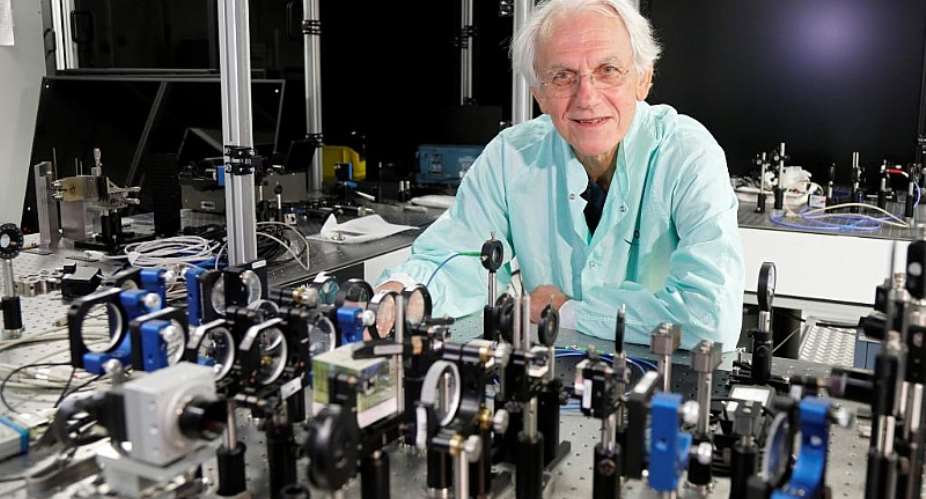French Nobel laureate for physics Gérard Mourou, one of the inventors of the laser technology with which eye-correction surgery is done, talks about the incredible accident that led to its discovery.
Arthur Ashkin, Gerard Mourou and Donna Strickland won this year's Nobel Prize in physics for their work lasers that have allowed millions of people to have corrective eye surgery.
In an exclusive interview with RFI's Dhananjay Khadilkar, Professor Mourou talks about his reaction on winning the Nobel Prize as well as the development and applications of his laser technique.
Here are some excerpts:
What does winning the Nobel Prize mean to you?
"It has always been a dream but you don't really think that one day you are going to get it. You work because you like physics.
"I work because physics is my passion, but its not for the Nobel Prize.
"But if you are good at what you are doing this is what can happen.
"You come up with some brilliant idea and get the Nobel Prize."
Can you describe the chirped pulse amplification technique?
"A laser is a very powerful beam of light.
"It turns out that when the power is too large you can damage the components that constitute the laser.
"So you cannot go higher in terms of intensity, in terms of power.
"In 1983, we invented a way where you could harness the full power from your laser.
"You have to trick the components a little bit by generating short pulses.
"These pulses have a really small amount of energy. You then stretch it, say, a million times.
"Because you stretch it, you decrease the intensity by a million times.
"So you can extract the energy a million times.
"And once the energy is extracted, you have a lot of energy, the pulse is long because you have stretched it.
"Then you have to compress it to the original value of a femtosecond [1/1015 of a second]
"As a result, you have huge peak power for short times."
What are some of the applications of this technique?
"At the beginning, we were not really expecting so many applications.
"We were interested in reactions of atoms to very high power of light.
"And then we discovered that we could use it for making new accelerators, micromachining, medical applications like in ophthalmology.
"And the reason why we could really do that is because the pulses are very short.
"You deposit the energy in a material, like the cornea in your eye, for an extremely short time.
"So there is no time for any damage to occur.
"What we have invented, so to speak, is the perfect scalpel.
"We can make cuts that are extremely precise and without any collateral damage.
"That's the reason why it is so important for eye surgery for instance."
How did your technique get applied in ophthalmology?
"It came totally by accident. And it was a real accident.
"One of my students was working on the new laser.
Accidentally, he got the laser beam in his eye.
Of course we took it very seriously and took the student to the hospital. The ophthalmologist looked at his eye and was very surprised.
"He asked 'What kind of a laser you have?'.
"They are familiar with lasers and this was a new type of laser. The student replied 'why do you ask?'.
"The doctor said 'because your damage is perfect'.
"Immediately, we realised we had something.
"The ophthalmologist called me a few days later and said he wanted to work in our group to do femtosecond ophthalmology.
"That was in 1993.
"And now it's a huge business.
"You have about 10 million people who get the procedure every year.





 Lay KPMG audit report on SML-GRA contract before Parliament – Isaac Adongo tells...
Lay KPMG audit report on SML-GRA contract before Parliament – Isaac Adongo tells...
 Supervisor remanded for stabbing businessman with broken bottle and screwdriver
Supervisor remanded for stabbing businessman with broken bottle and screwdriver
 NDC watching EC and NPP closely on Returning Officer recruitment — Omane Boamah
NDC watching EC and NPP closely on Returning Officer recruitment — Omane Boamah
 Your decision to contest for president again is pathetic – Annoh-Dompreh blasts ...
Your decision to contest for president again is pathetic – Annoh-Dompreh blasts ...
 Election 2024: Security agencies ready to keep peace and secure the country — IG...
Election 2024: Security agencies ready to keep peace and secure the country — IG...
 People no longer place value in public basic schools; new uniforms, painting wil...
People no longer place value in public basic schools; new uniforms, painting wil...
 'Comedian' Paul Adom Otchere needs help – Sulemana Braimah
'Comedian' Paul Adom Otchere needs help – Sulemana Braimah
 Ejisu by-election: Only 33% of voters can be swayed by inducement — Global InfoA...
Ejisu by-election: Only 33% of voters can be swayed by inducement — Global InfoA...
 Minority will expose the beneficial owners of SML, recover funds paid to company...
Minority will expose the beneficial owners of SML, recover funds paid to company...
 Prof. Opoku-Agyemang has ‘decapitated’ the NPP’s strategies; don’t take them ser...
Prof. Opoku-Agyemang has ‘decapitated’ the NPP’s strategies; don’t take them ser...
